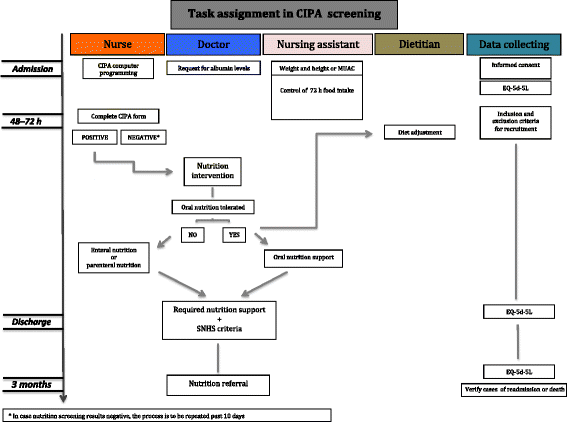Clinical and cost-effectiveness analysis of early detection of patients at nutrition risk during their hospital stay through the new screening method CIPA: a study protocol
- PMID: 28424063
- PMCID: PMC5397674
- DOI: 10.1186/s12913-017-2218-z
Clinical and cost-effectiveness analysis of early detection of patients at nutrition risk during their hospital stay through the new screening method CIPA: a study protocol
Abstract
Background: Malnutrition is highly prevalent in hospitalized patients and results in a worsened clinical course as well as an increased length of stay, mortality, and costs. Therefore, simple nutrition screening systems, such as CIPA (control of food intake, protein, anthropometry), may be implemented to facilitate the patient's recovery process. The aim of this study is to evaluate the effectiveness and cost-effectiveness of implementing such screening tool in a tertiary hospital, consistent with the lack of similar, published studies on any hospital nutrition screening system.
Methods: The present study is carried out as an open, controlled, randomized study on patients that were admitted to the Internal Medicine and the General and Digestive Surgery ward; the patients were randomized to either a control or an intervention group (n = 824, thereof 412 patients in each of the two study arms). The control group underwent usual inpatient clinical care, while the intervention group was evaluated with the CIPA screening tool for early detection of malnutrition and treated accordingly. CIPA nutrition screening was performed upon hospital admission and classified positive when at least one of the following parameters was met: 72 h food intake control < 50%, serum albumin < 3 g/dL, body mass index < 18.5 kg/m2 (or mid-upper arm circumference ≤ 22.5 cm). In this case, the doctor decided on whether or not providing nutrition support. The following variables will be evaluated: hospital length of stay (primary endpoint), mortality, 3-month readmission, and in-hospital complications. Likewise, the quality of life questionnaires EQ-5D-5 L are being collected for all patients at hospital admission, discharge, and 3 months post-discharge. Analysis of cost-effectiveness will be performed by measuring effectiveness in terms of quality-adjusted life years (QALYs). The cost per patient will be established by identifying health care resource utilization; cost-effectiveness will be determined through the incremental cost-effectiveness ratio (ICER). We will calculate the incremental cost per QALY gained with respect to the intervention.
Discussion: This ongoing trial aims to evaluate the cost-effectiveness of implementing the malnutrition screening tool CIPA in a tertiary hospital.
Trial registration: Clinical Trial.gov ( NCT02721706 ). First receivevd: March 1, 2016 Last updated: April 8, 2017 Last verified: April 2017.
Keywords: Anthropometry; Body composition; Cost-benefit analysis; Inpatients; Malnutrition; Mass screening; Nutrition assessment; Quality of life.
Figures
Similar articles
-
Comparison of Clinical Outcomes in Surgical Patients Subjected to CIPA Nutrition Screening and Treatment versus Standard Care.Nutrients. 2019 Apr 20;11(4):889. doi: 10.3390/nu11040889. Nutrients. 2019. PMID: 31010007 Free PMC article. Clinical Trial.
-
Cost-effectiveness of the hospital nutrition screening tool CIPA.Arch Med Sci. 2019 Jan 11;16(2):273-281. doi: 10.5114/aoms.2018.81128. eCollection 2020. Arch Med Sci. 2019. PMID: 32190136 Free PMC article.
-
[Optimisation of nutritional screening tool CIPA: are two parameters of protein really necessary?].Nutr Hosp. 2018 Aug 2;35(4):914-919. doi: 10.20960/nh.1701. Nutr Hosp. 2018. PMID: 30070882 Spanish.
-
Targeting malnutrition: Nutrition programs yield cost savings for hospitalized patients.Clin Nutr. 2020 Sep;39(9):2896-2901. doi: 10.1016/j.clnu.2019.12.025. Epub 2019 Dec 26. Clin Nutr. 2020. PMID: 31917050 Review.
-
Optimizing Inpatient Nutrition Care of Adult Patients with Inflammatory Bowel Disease in the 21st Century.Nutrients. 2021 May 9;13(5):1581. doi: 10.3390/nu13051581. Nutrients. 2021. PMID: 34065070 Free PMC article. Review.
Cited by
-
Comparison of Clinical Outcomes in Surgical Patients Subjected to CIPA Nutrition Screening and Treatment versus Standard Care.Nutrients. 2019 Apr 20;11(4):889. doi: 10.3390/nu11040889. Nutrients. 2019. PMID: 31010007 Free PMC article. Clinical Trial.
-
Cost-Effectiveness Analysis of Standardized Clinical Nutrition Diagnosis and Treatment Pathway in Patients with Pulmonary Infection.Comput Math Methods Med. 2022 Jul 26;2022:6706390. doi: 10.1155/2022/6706390. eCollection 2022. Comput Math Methods Med. 2022. Retraction in: Comput Math Methods Med. 2023 Jul 19;2023:9783407. doi: 10.1155/2023/9783407. PMID: 35928981 Free PMC article. Retracted.
-
The continuous downgrading of malnutrition in the German DRG system: possible effects on the treatment of patients at risk for malnutrition.EXCLI J. 2019 Jun 12;18:370-381. doi: 10.17179/excli2019-1256. eCollection 2019. EXCLI J. 2019. PMID: 31338008 Free PMC article.
-
Comparison of CIPA Nutritional Screening with GLIM Criteria for Malnutrition, Prognostic Evolution, and Association with Phase Angle in Hospitalized Patients.Nutrients. 2024 Oct 26;16(21):3652. doi: 10.3390/nu16213652. Nutrients. 2024. PMID: 39519485 Free PMC article.
-
Influence of the Results of Control of Intakes, Proteins and Anthropometry Nutritional Screening, Sarcopenia and Body Composition on the Clinical Evolution of Hospitalized Patients.Nutrients. 2023 Dec 20;16(1):14. doi: 10.3390/nu16010014. Nutrients. 2023. PMID: 38201844 Free PMC article.
References
-
- Alvarez-Hernández J, Planas Vila M, León-Sanz M, Garcíade Lorenzo A, Celaya-Pérez S, García-Lorda P, et al. Prevalence and costs of malnutrition in hospitalized patients; the PREDyCES Study. Nutr Hosp. 2012;27:1049–59. - PubMed
Publication types
MeSH terms
Substances
Associated data
LinkOut - more resources
Full Text Sources
Other Literature Sources
Medical
Miscellaneous



